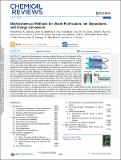Electrochemical Methods for Water Purification, Ion Separations, and Energy Conversion
Author(s)
Alkhadra, Mohammad A; Su, Xiao; Suss, Matthew E; Tian, Huanhuan; Guyes, Eric N; Shocron, Amit N; Conforti, Kameron M; de Souza, J Pedro; Kim, Nayeong; Tedesco, Michele; Khoiruddin, Khoiruddin; Wenten, I Gede; Santiago, Juan G; Hatton, T Alan; Bazant, Martin Z; ... Show more Show less
DownloadPublished version (51.54Mb)
Publisher with Creative Commons License
Publisher with Creative Commons License
Creative Commons Attribution
Terms of use
Metadata
Show full item recordAbstract
Agricultural development, extensive industrialization, and rapid growth of the global population have inadvertently been accompanied by environmental pollution. Water pollution is exacerbated by the decreasing ability of traditional treatment methods to comply with tightening environmental standards. This review provides a comprehensive description of the principles and applications of electrochemical methods for water purification, ion separations, and energy conversion. Electrochemical methods have attractive features such as compact size, chemical selectivity, broad applicability, and reduced generation of secondary waste. Perhaps the greatest advantage of electrochemical methods, however, is that they remove contaminants directly from the water, while other technologies extract the water from the contaminants, which enables efficient removal of trace pollutants. The review begins with an overview of conventional electrochemical methods, which drive chemical or physical transformations via Faradaic reactions at electrodes, and proceeds to a detailed examination of the two primary mechanisms by which contaminants are separated in nondestructive electrochemical processes, namely electrokinetics and electrosorption. In these sections, special attention is given to emerging methods, such as shock electrodialysis and Faradaic electrosorption. Given the importance of generating clean, renewable energy, which may sometimes be combined with water purification, the review also discusses inverse methods of electrochemical energy conversion based on reverse electrosorption, electrowetting, and electrokinetic phenomena. The review concludes with a discussion of technology comparisons, remaining challenges, and potential innovations for the field such as process intensification and technoeconomic optimization.
Date issued
2022-08-24Department
Massachusetts Institute of Technology. Department of Chemical Engineering; Massachusetts Institute of Technology. Department of MathematicsJournal
Chemical Reviews
Publisher
American Chemical Society
Citation
Chem. Rev. 2022, 122, 16, 13547–13635